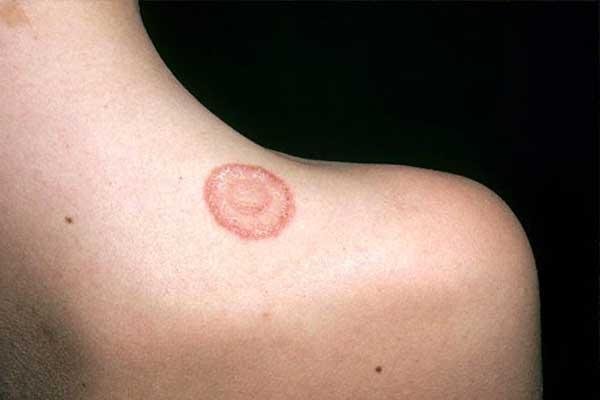What is ringworm?
Ringworm, also known as dermatophytosis or tinea, is a fungal infection of the skin. The name “ringworm” is a misnomer, since the infection is caused by a fungus, not a worm.
Ringworm infection can affect both humans and animals. The infection initially presents with red patches on affected areas of the skin and later spreads to other parts of the body. The infection may affect the skin of the scalp, feet, groin, beard, or other areas.
Recognizing ringworm
Symptoms vary depending on where you’re infected. With a skin infection, you may experience the following:
- red, itchy, scaly, or raised patches
- patches that develop blisters or begin to ooze
- patches that may be redder on the outside edges or resemble a ring
- patches with edges that are defined and raised
If you’re experiencing dermatophytosis in your nails, they may become thicker or discolored, or they may begin to crack. If the scalp is affected, the hair around it may break or fall off, and bald patches may develop.
Types of ringworm
Ringworm can go by different names depending on the part of the body affected.
- Ringworm of the scalp (tinea capitis) often starts as small sores that develop into itchy, scaly bald patches. It is most common among children.
- Ringworm of the body (tinea corporis) often appears as patches with the characteristic round “ring” shape.
- Jock itch (tinea cruris) refers to ringworm infection of the skin around the groin, inner thighs, and buttocks. It is most common in men and adolescent boys.
- Athlete’s foot (tinea pedis) is the common name for ringworm infection of the foot. It is frequently seen in people who go barefoot in public places where the infection can spread, such as locker rooms, showers, and swimming pools.
What causes ringworm?
Three different types of fungi can cause this infection. They are called trichophyton, microsporum, and epidermophyton. It’s possible that these fungi may live for an extended period as spores in soil. Humans and animals can contract ringworm after direct contact with this soil. The infection can also spread through contact with infected animals or humans. The infection is commonly spread among children and by sharing items that may not be clean.
Anyone can develop ringworm. However, the infection is very common among children and people who own pet cats. Both cats and dogs can catch ringworm and then pass it on to humans who touch them. Signs to be aware of in pets include:
- hairless patches of skin that appear circular
- crusty or scaly patches
- patches that may not be completely hairless but have brittle or broken hairs
- opaque or whitish areas around the claws
You may be more likely to develop dermatophytosis if you come into contact with the fungi while you’re wet or if you have minor skin injuries or abrasions. Using a public shower or public pool areas may also expose you to the infective fungi.
If you’re often barefoot, you may develop ringworm of the feet (athlete’s foot). Those who often share items such as hairbrushes or unwashed clothing also have an increased risk of developing the infection.
Diagnosing ringworm
Your doctor will diagnose ringworm by examining your skin and possibly using a black light to view your skin in the affected area. The fungus will fluoresce (glow) under black light. If you’re infected, the areas of the skin where fungus is located will glow.
Your doctor may confirm a suspected diagnosis of ringworm by requesting certain tests:
- If you’re getting either a skin biopsy or fungal culture, your doctor will take a sample of your skin or discharge from a blister and send it to a lab to test it for the presence of fungus.
- If you’re getting a KOH exam, your doctor will scrape off a small area of infected skin and place it in potassium hydroxide (KOH). The KOH destroys normal cells and leaves the fungal cells untouched, so they’re easy to see under a microscope.
TREATMENT
Treating ringworm
Your doctor may recommend both medications and lifestyle adjustments to treat ringworm.
Medication
Your doctor may prescribe various medications depending on the severity of your ringworm infection. Jock itch, athlete’s foot, and ringworm of the body can all be treated with topical medications, such as antifungal creams, ointments, gels, or sprays. Ringworm of the scalp or nails may require prescription-strength oral medications such as ketoconazole, griseofulvin, or terbinafine.
Over-the-counter medications and antifungal skin creams may be recommended for use as well. Over-the-counter products may contain clotrimazole, miconazole, terbinafine, or other related ingredients. Find antifungal treatments on Amazon.
Home care
In addition to prescription and over-the-counter medication, your doctor may recommend that you care for your infection at home by practicing some of the following behaviors:
- avoid clothing that irritates the infected area
- cover it with a bandage if you’re unable to avoid clothing that irritates the area
- wash bedding and clothes daily during an infection to help disinfect your surroundings
- clean and dry your skin regularly
If you’ve been scratching your skin frequently due to the infection, you may also develop a staph or strep infection of the skin. Your doctor may prescribe antibiotics to treat this bacterial infection as you continue your treatment for the ringworm.
Preventing ringworm
You can prevent ringworm by practicing healthy and hygienic behaviors. Many infections come from contact with animals and lack of proper hygiene. Tips to avoid ringworm include:
- wash your hands after interacting with an animal
- disinfect and clean pet living areas
- avoid people or animals with ringworm if you have a weakened immune system
- shower and shampoo your hair regularly
- wear shoes if showering in community areas
- avoid sharing personal items like clothing or hairbrushes with people who might have ringworm
- keep your feet clean and dry










No comments:
Post a Comment